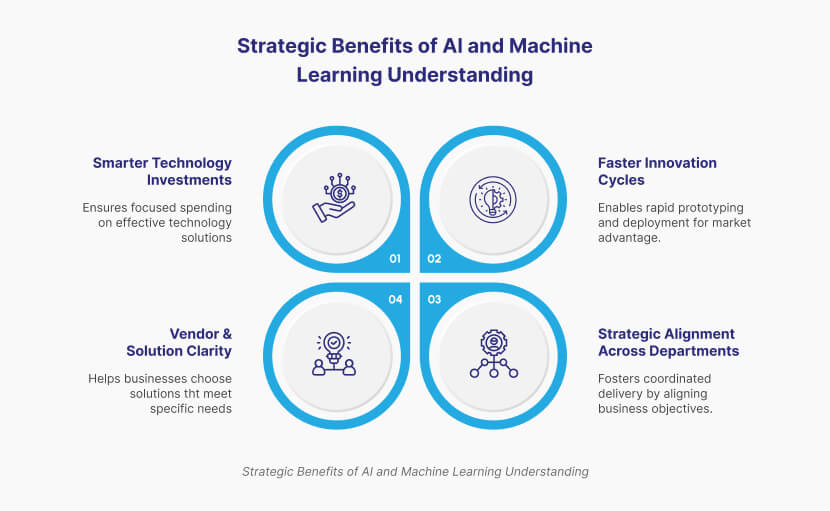AI vs Machine Learning: What’s the Difference and Why It Matters for Your Enterprise
Introduction
A Enterprise leaders often use artificial intelligence (AI) and machine learning (ML) interchangeably, but calibrating their differences is crucial. Confusing these terms can lead to misaligned strategies and missed opportunities.
This confusion is widespread and can lead to costly business decisions. While both AI and ML drive innovation, understanding their core differences is key to making smarter tech investments, building scalable systems, and solving real enterprise challenges.
In this blog, we clarify what AI and machine learning actually mean, explore the key differences, and explore why this difference between AI and ML is relevant for any enterprise navigating to grow in a fast-moving digital world.
Key Difference Between Machine Learning And Artificial Intelligence
Meaning and Scope
Artificial intelligence is a broad concept aimed at creating machines that simulate human thinking, while machine learning is a part of AI focused on systems that learn from data to make decisions or predictions without being specifically programmed for each task.
Human Involvement and Learning Dependency
AI is frequently reliant on human command, whereas machine learning learns from data. This distinction leads to differences in scalability and accuracy when making choices over vast datasets.
Continuous Learning and Adaptation
Machine learning continuously evolves with new data, whereas traditional AI remains static. This adaptability presents machine learning with a clear edge in dynamic and data-rich environments.
System-Led Decision Processes
Machine learning models self-adjust to deliver outcomes, enabling greater autonomy. AI, without learning algorithms, depends on fixed logic, limiting its capacity to improve choices without human input.
Response to Changing Environments
Machine learning models adapt in real-time to fluctuating data streams. Traditional AI lacks this flexibility, making ML more practical for use cases like fraud detection, demand forecasting, or personalisation.
Improvement through Errors
AI systems need manual adjustments after errors, reducing their efficiency in environments requiring continuous performance enhancement or feedback-based improvements. At the same time, ML algorithms learn from incorrect predictions and updates and train themselves not to repeat the same in the future.
Importance of knowing the difference between AI and machine learning for enterprises
1. Smarter Technology Investments
Businesses often spend money on compromised technology solutions. By distinguishing between deep learning, machine learning, and AI, leaders can assess the true requirements, resulting in more focused investments and avoiding unrealistic project scopes.A significant advantage of augmented analytics is its ability to democratise and break down barriers surrounding complex data tasks. With the assistance of augmented business intelligence, enterprises can avoid the need for technical teams, allowing more operational teams to engage with data and contribute analytics-led strategies. This approach helps build a stronger and more inclusive data culture across the enterprise.
2. Vendor & Solution Clarity
Overcomplicated language in vendor proposals often hides the true capabilities of a solution. Businesses must understand the distinction between AI and machine learning to penetrate the hype, ask smarter questions, and choose platforms that meet company-specific requirements rather than abstract guarantees.
3. Scalability & Risk Mitigation
Short-sighted tech choices risk long-term disruption. Understanding how deep learning vs machine learning solutions scale helps enterprises manage data growth responsibly and build adaptable systems that reduce risks while preparing for emerging compliance and ethical demands.With augmented analytics, you’re no longer just analysing what’s happened; enterprises are actually getting foresight. By revealing patterns and forecasting future outcomes, it enables teams to prepare for market shifts, customer requirements, and prevent challenges before they get escalated.
4. Strategic Alignment Across Departments
Departments are frequently silos, adopting tech piecemeal. Understanding the distinctions between AI and machine learning establishes a common language among teams, enabling them to connect business objectives, data science capabilities, and systems infrastructure to ensure coordinated delivery.
5. Faster Innovation Cycles
Slow product development is a big barrier to market. Understanding machine learning versus AI enables teams to prototype, test, and deploy more rapidly and automatically. This helps in choosing models that fit timelines and data sources without overengineering or undervaluing current assets.
6. Resource Planning & Talent Hiring
Recruiting the unmatched talent inhibits innovation. With a clear understanding of how AI compares to machine learning, businesses can pinpoint precise skill shortages, whether for modelling, automation, or analytics, and build teams that speed up results without overstaffing.

About SquareOne
With over 16 years of experience, SquareOne is a leading digital transformation partner in the Kingdom of Saudi Arabia region. By embracing the trusted partnership and industrial expertise, SquareOne optimises business operations through the power of intelligent automation, AI-driven insights, and cloud-based solutions.
Specifically in the AI and ML solutions, a team of experts enables enterprises to improve efficiency, enhance compliance, and strengthen decision-making. By leveraging prominent technologies and offering tailored strategies, SquareOne enables businesses to streamline their processes and drive sustainable growth.
Conclusion
Understanding the difference between AI and ML is a strategic imperative. Enterprises that grasp this divide are better positioned to innovate responsibly, reduce risk, and stay ahead of the curve. The unique roles of AI and ML solutions allow enterprises to make smarter technology choices aligned with their enterprise goals, market demands and operational needs.
Looking to build an intelligent, future-ready enterprise? Connect with SquareOne to get end to end AI and ML solutions and strategies tailored to your enterprise goals.
















